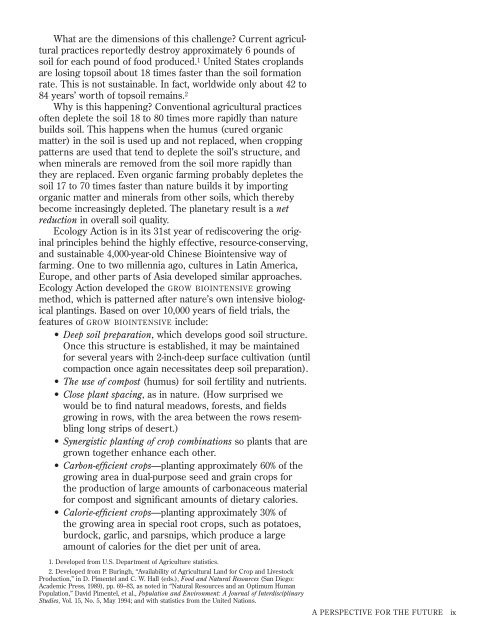How to Grow More Vegetables : And Fruits, Nuts ... - Shroomery
How to Grow More Vegetables : And Fruits, Nuts ... - Shroomery
How to Grow More Vegetables : And Fruits, Nuts ... - Shroomery
Create successful ePaper yourself
Turn your PDF publications into a flip-book with our unique Google optimized e-Paper software.
What are the dimensions of this challenge? Current agricultural<br />
practices reportedly destroy approximately 6 pounds of<br />
soil for each pound of food produced. 1 United States croplands<br />
are losing <strong>to</strong>psoil about 18 times faster than the soil formation<br />
rate. This is not sustainable. In fact, worldwide only about 42 <strong>to</strong><br />
84 years’ worth of <strong>to</strong>psoil remains. 2<br />
Why is this happening? Conventional agricultural practices<br />
often deplete the soil 18 <strong>to</strong> 80 times more rapidly than nature<br />
builds soil. This happens when the humus (cured organic<br />
matter) in the soil is used up and not replaced, when cropping<br />
patterns are used that tend <strong>to</strong> deplete the soil’s structure, and<br />
when minerals are removed from the soil more rapidly than<br />
they are replaced. Even organic farming probably depletes the<br />
soil 17 <strong>to</strong> 70 times faster than nature builds it by importing<br />
organic matter and minerals from other soils, which thereby<br />
become increasingly depleted. The planetary result is a net<br />
reduction in overall soil quality.<br />
Ecology Action is in its 31st year of rediscovering the original<br />
principles behind the highly effective, resource-conserving,<br />
and sustainable 4,000-year-old Chinese Biointensive way of<br />
farming. One <strong>to</strong> two millennia ago, cultures in Latin America,<br />
Europe, and other parts of Asia developed similar approaches.<br />
Ecology Action developed the GROW BIOINTENSIVE growing<br />
method, which is patterned after nature’s own intensive biological<br />
plantings. Based on over 10,000 years of field trials, the<br />
features of GROW BIOINTENSIVE include:<br />
• Deep soil preparation, which develops good soil structure.<br />
Once this structure is established, it may be maintained<br />
for several years with 2-inch-deep surface cultivation (until<br />
compaction once again necessitates deep soil preparation).<br />
• The use of compost (humus) for soil fertility and nutrients.<br />
• Close plant spacing, as in nature. (<strong>How</strong> surprised we<br />
would be <strong>to</strong> find natural meadows, forests, and fields<br />
growing in rows, with the area between the rows resembling<br />
long strips of desert.)<br />
• Synergistic planting of crop combinations so plants that are<br />
grown <strong>to</strong>gether enhance each other.<br />
• Carbon-efficient crops—planting approximately 60% of the<br />
growing area in dual-purpose seed and grain crops for<br />
the production of large amounts of carbonaceous material<br />
for compost and significant amounts of dietary calories.<br />
• Calorie-efficient crops—planting approximately 30% of<br />
the growing area in special root crops, such as pota<strong>to</strong>es,<br />
burdock, garlic, and parsnips, which produce a large<br />
amount of calories for the diet per unit of area.<br />
1. Developed from U.S. Department of Agriculture statistics.<br />
2. Developed from P. Buringh, “Availability of Agricultural Land for Crop and Lives<strong>to</strong>ck<br />
Production,” in D. Pimentel and C. W. Hall (eds.), Food and Natural Resources (San Diego:<br />
Academic Press, 1989), pp. 69–83, as noted in “Natural Resources and an Optimum Human<br />
Population,” David Pimentel, et al., Population and Environment: A Journal of Interdisciplinary<br />
Studies, Vol. 15, No. 5, May 1994; and with statistics from the United Nations.<br />
A PERSPECTIVE FOR THE FUTURE ix












